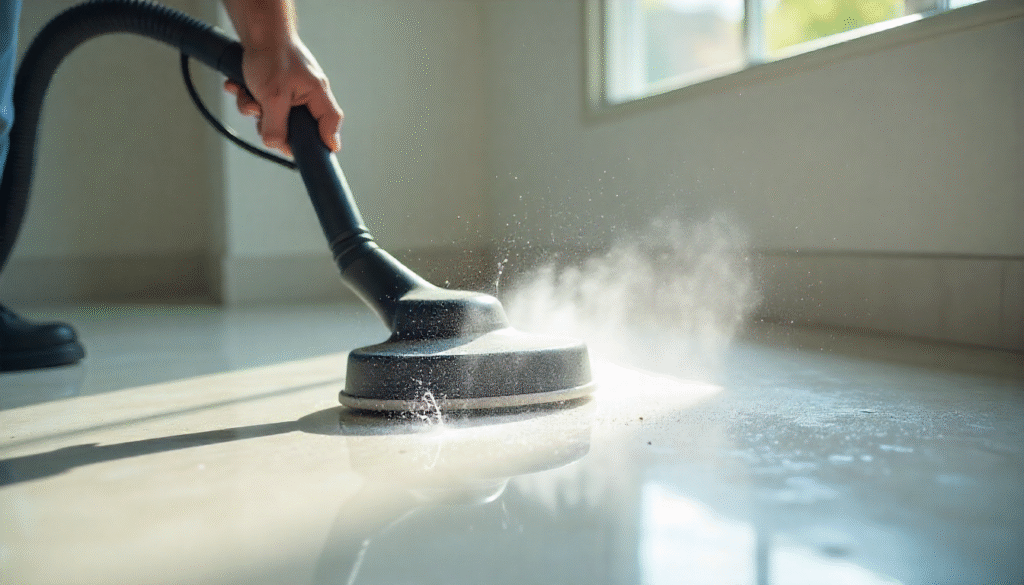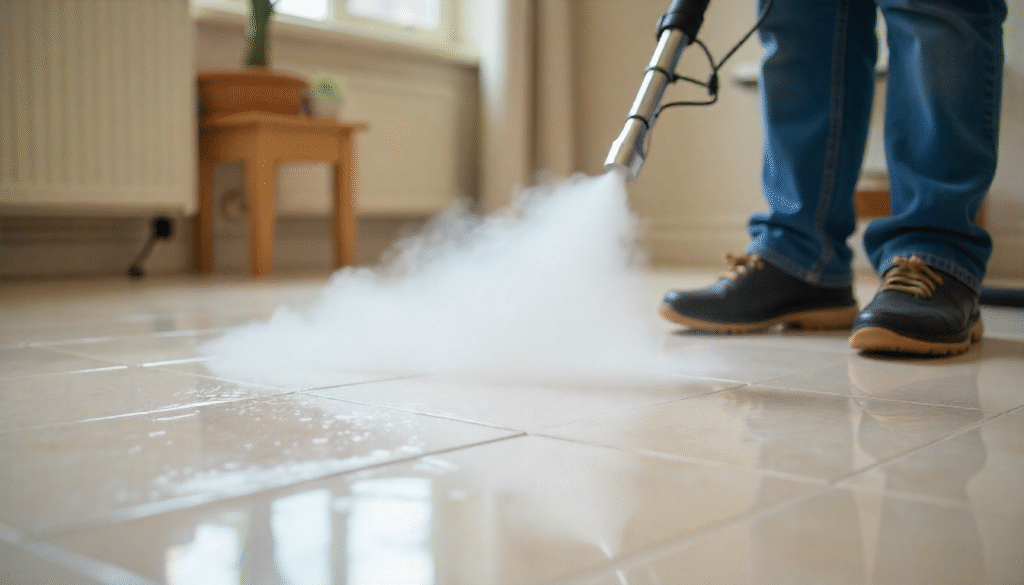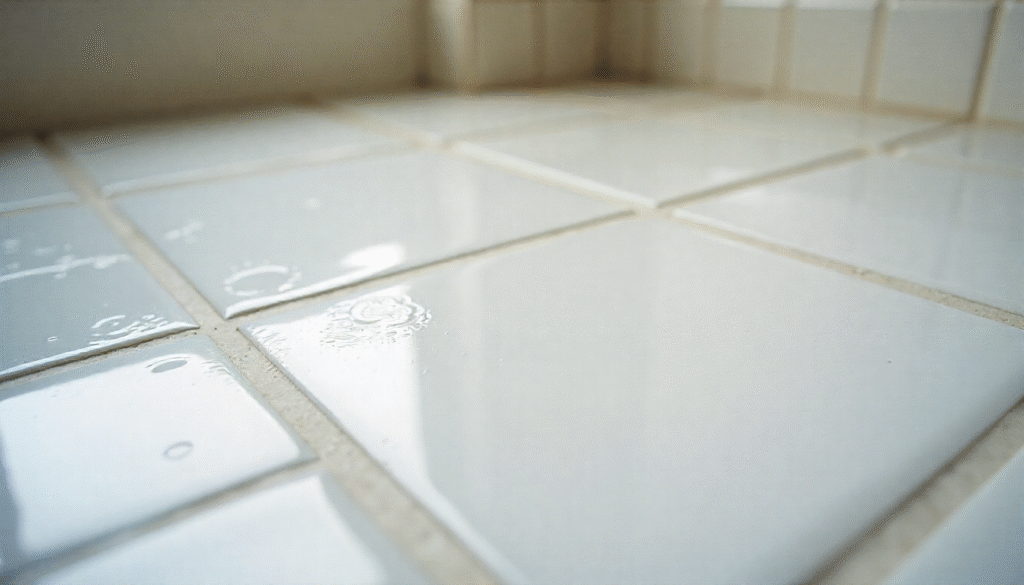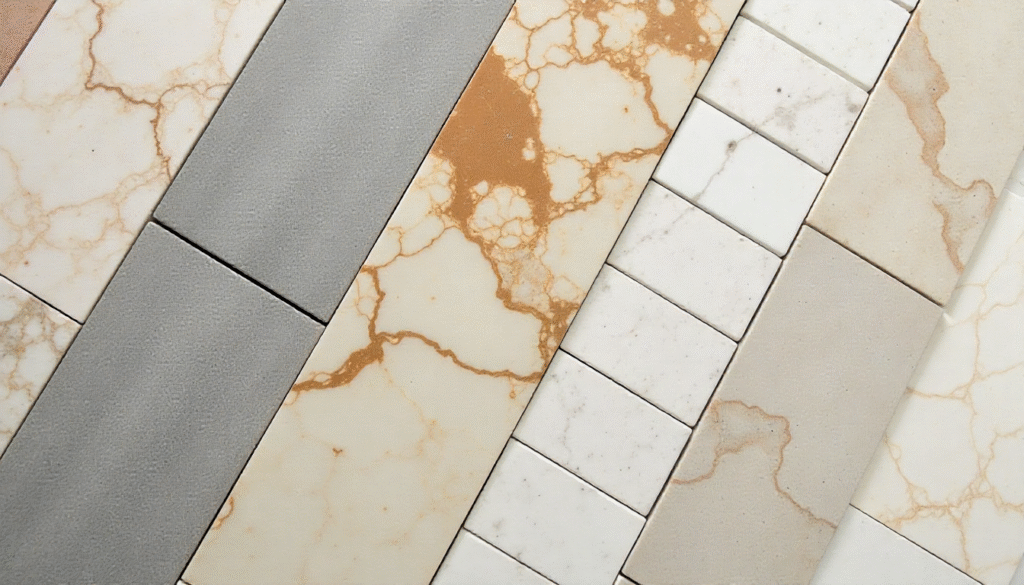
Introduction:
Will a steam cleaner clean grout and bring back the shine to your tiles? If you’ve ever struggled with grimy grout lines that refuse to look clean no matter how hard you scrub, you’re not alone. Grout easily traps dirt, mold, and soap scum, making it one of the toughest areas to maintain. Fortunately, steam cleaning offers a chemical-free and highly effective solution. In this guide, we’ll explore how steam cleaners work, whether they truly clean grout effectively, and the best tips to keep your grout looking fresh and spotless for longer.
Table of Contents
Understanding Grout and Why It Gets Dirty
Grout plays an important role in keeping your tiles securely in place and giving them a neat, finished look. However, over time, grout lines can turn dark, stained, or even moldy — leaving homeowners wondering, will a steam cleaner clean grout and bring it back to its original color? To answer that, it helps to first understand what grout is and why it attracts so much dirt.
What Is Grout?
Grout is a porous mixture made from water, cement, and sometimes sand. It fills the gaps between tiles to prevent moisture from seeping underneath and to keep the surface smooth and sealed.
However, that same porous texture that makes grout flexible and easy to apply also makes it prone to absorbing dirt, grime, and liquids.
Why Does Grout Get Dirty So Easily?
Several factors contribute to grout discoloration and buildup:
- Moisture and Humidity:
In bathrooms or kitchens, constant moisture encourages mold and mildew growth. These fungi thrive in damp grout lines, leaving black or green stains. - Soap Scum and Cleaning Residue:
When cleaning products or soap mix with water, they can leave behind residue that gradually sticks to grout, making it dull and grimy. - Dirt and Foot Traffic:
On floors, grout easily traps dirt from shoes, pets, and spills. Since grout lines are slightly lower than tiles, they act like tiny gutters that collect debris. - Hard Water Deposits:
In areas with hard water, mineral deposits can build up on tiles and grout, leaving a white or yellowish film.
Why Regular Cleaning Isn’t Enough
Typical mopping or surface cleaning often only removes dirt from the tile surface — not from within the grout’s tiny pores. This is why many homeowners eventually ask, “will a steam cleaner clean grout more effectively?”
The short answer is yes — but understanding why grout holds onto grime helps explain why steam cleaning works better than most other methods.
How Does a Steam Cleaner Function and What Is It Used For?
Before we answer the big question — will a steam cleaner clean grout effectively? — it’s helpful to understand how this cleaning tool actually works. Steam cleaners use the power of high-temperature steam to remove dirt, bacteria, and grime from surfaces without the need for harsh chemicals.
What Exactly Is a Steam Cleaner?
A steam cleaner is a household or professional cleaning device that heats water to produce pressurized steam. This steam is then directed through a nozzle or brush attachment to loosen and lift dirt from a variety of surfaces — including tile floors, countertops, upholstery, and yes, grout.
Because steam reaches temperatures above 200°F (93°C), it not only dissolves stubborn buildup but also kills germs, mold, and mildew on contact. This makes it one of the most eco-friendly cleaning tools available.

How Does a Steam Cleaner Work?
The process behind steam cleaning is simple but powerful:
- Water Tank Heating:
The steam cleaner heats water inside its tank until it turns into vapor. - Pressurized Steam Release:
Once the right temperature and pressure are reached, the steam is released through a nozzle, jet, or brush attachment. - Dirt and Stain Removal:
The hot steam penetrates porous surfaces like grout, breaking down dirt, grease, and bacteria that regular mopping can’t reach. - Wiping or Extraction:
As the loosened grime rises to the surface, it’s wiped away with a microfiber cloth or vacuum attachment, leaving the area fresh and sanitized.
Types of Steam Cleaners
Different steam cleaners are available, each suitable for specific cleaning tasks:
- Handheld Steam Cleaners: Ideal for small areas like bathroom tiles and grout lines.
- Canister Steam Cleaners: Provide higher steam pressure and longer cleaning sessions.
- Steam Mops: Convenient for floors and larger tiled spaces.
- Multi-Purpose Steam Cleaners: Versatile machines that come with various attachments for different surfaces.
Why Steam Cleaning Works So Well on Grout
Grout is porous, meaning it traps dirt deep inside. The high-temperature steam penetrates those tiny pores, loosens grime, and sanitizes without chemicals. This is why when people ask, “will a steam cleaner clean grout better than scrubbing?” the answer is often yes — it delivers a deep clean that traditional methods can’t match.
Will a Steam Cleaner Clean Grout Effectively?
If you’ve ever scrubbed your tile floors or shower walls for hours with little success, you’ve probably wondered, will a steam cleaner clean grout effectively? The short answer is yes — a steam cleaner can be one of the most powerful and chemical-free ways to restore dirty grout to its original color.
Let’s break down how and why steam cleaners work so well for grout cleaning.
How Steam Cleaners Remove Grime from Grout
Steam cleaners use extremely hot vapour to penetrate the tiny pores of grout. This heat softens and loosens the trapped dirt, mild, and soap residue that without regular scrubbing can’t reach. As the steam lifts the grime, you simply wipe it away with a clean microfiber cloth or mop — leaving the grout looking fresh and bright again.
Why Steam Cleaning Works Better Than Traditional Methods
Traditional grout cleaning methods often rely on harsh chemicals, bleach, or hours of manual scrubbing. While these can remove surface dirt, they don’t always reach deep inside the grout.
A steam cleaner, on the other hand:
- Reaches deep into grout pores to lift out stubborn buildup.
- Sanitizes the surface by killing germs, mold, and mildew.
- Requires no chemicals, making it safer for families and pets.
- Works faster and with less physical effort.
So when you ask, “will a steam cleaner clean grout better than using bleach or vinegar?” — in most situations, the answer is definitely yes.
When Steam Cleaning May Not Be Enough
While steam cleaning is highly effective, it’s not a cure-all. There are a few situations where it may not deliver perfect results:
- Old or deeply stained grout: Some discoloration may be permanent.
- Unsealed grout: Steam may drive moisture deeper, causing potential damage.
- Cracked or damaged grout lines: Steam pressure can worsen cracks.
If your grout falls into these categories, you may need grout restoration or professional deep cleaning before using a steam cleaner regularly.
Best Results: Combine Steam with Good Maintenance
For lasting results, seal your grout after cleaning. A good grout sealer prevents moisture, dirt, and mold from penetrating again — keeping your tiles cleaner for longer. Regular light cleaning combined with occasional steam treatments can keep grout looking new for years.
Final Verdict
So, will a steam cleaner clean grout effectively?
Yes — when used correctly, a steam cleaner can remove dirt, kill bacteria, and restore grout color without harsh chemicals. It’s one of the most efficient and eco-friendly cleaning methods for tiles and grout.
Step-by-Step: How to Clean Grout with a Steam Cleaner
Now that we’ve answered the question “will a steam cleaner clean grout effectively?”, Let’s go over the proper method to get it done. Steam cleaning grout is simple, but following the correct steps ensures you get the best results without damaging your tiles or grout lines.
Here’s a complete, step-by-step guide:
Step 1: Prepare the Area
Before you start, remove any rugs, mats, or movable items from the area you’re cleaning. Sweep or vacuum the floor to remove loose dust, hair, and debris. This prevents dirt from spreading once the steam hits the surface.
Step 2: Fill and Heat the Steam Cleaner
Fill your steam cleaner’s tank with clean water according to the manufacturer’s instructions. Avoid adding chemicals or detergents unless the device specifically allows it — steam alone is powerful enough.
Once filled, turn on the machine and wait until it reaches the proper temperature (usually takes 5–10 minutes).
Step 3: Attach the Right Nozzle or Brush
Most steam cleaners come with a narrow nozzle or small brush attachment designed for grout lines. Attach this piece for more targeted cleaning — it helps direct the steam precisely where it’s needed.
Step 4: Steam the Grout Lines
Hold the steam nozzle a few inches above the grout line and slowly move it along the joints. Let the high-temperature steam loosen dirt and buildup. For stubborn areas, pause briefly or use gentle scrubbing motions with the brush attachment.
Step 5: Wipe Away Dirt and Residue
As the steam lifts grime from the grout, use a microfiber cloth or mop to wipe the area clean. This step is important — if you skip it, loosened dirt may resettle on your tiles.
Step 6: Let It Dry Completely
Allow the grout and tiles to air-dry completely before walking on them or applying a sealer. Opening windows or turning on a fan can help speed up drying.
Step 7: Seal the Grout (Optional but Recommended)
Once the grout is clean and dry, apply a grout sealer to protect it from future stains and moisture. Sealing keeps your grout looking cleaner for longer and reduces how often you’ll need to steam clean again.
Pro Tip:
When tackling a large surface, clean it one small section at a time.
. This ensures the steam stays hot and effective, and you can wipe up loosened grime before it dries again.
Final Thought
By following these steps, you can see firsthand that the answer to “will a steam cleaner clean grout?” is yes — and the process is simpler than most people think. With the right tools and technique, steam cleaning can make your grout look brand new without chemicals or endless scrubbing.
Pros and Cons of Using a Steam Cleaner for Grout
Before you decide whether to invest in one, it’s important to understand both the advantages and limitations of steam cleaning grout. Many people ask, “will a steam cleaner clean grout effectively and safely?” The answer depends on how — and where — you use it.
Let’s look at the pros and cons to help you make an informed choice.
Pros of Using a Steam Cleaner for Grout
- Deep, Chemical-Free Cleaning
Steam cleaners use only water — no bleach, no harsh chemicals. The high-temperature steam penetrates grout pores to loosen and lift dirt, bacteria, and mildew naturally. - Kills Germs and Mold
The heat produced by a steam cleaner can kill up to 99.9% of germs, mold spores, and bacteria living in grout. This makes it ideal for bathrooms, kitchens, and other damp areas prone to mildew. - Restores Grout Color
Over time, grout turns gray or discolored. Steam cleaning can restore its original color by removing trapped grime and soap residue — making your floors and tiles look newer and brighter. - Eco-Friendly and Safe for Families
Since no chemicals are needed, steam cleaning is safer for households with kids or pets. It’s also environmentally friendly, producing no harmful fumes or residues. - Saves Time and Effort
Compared to scrubbing grout lines by hand, steam cleaning is much faster and easier. You let the steam do most of the work, minimizing physical strain.

Cons of Using a Steam Cleaner for Grout
- Not Suitable for Unsealed or Damaged Grout
If your grout is cracked or unsealed, the moisture from the steam can seep in and cause further damage. Always check and repair grout before cleaning. - May Not Remove Deep Stains
While steam cleaning is effective for surface-level dirt, it might not remove permanent stains caused by age or water damage. These may require professional restoration. - Takes Time for Large Areas
Cleaning small areas like bathroom tiles is quick, but larger rooms can take longer because you need to work in small sections for best results. - Initial Cost of Equipment
Quality steam cleaners can be expensive, though they pay off over time if you plan to use them regularly for multiple cleaning tasks. - Requires Caution with Delicate Materials
Some tile types, like soft natural stone, may not react well to high heat. Always test a small area first to avoid potential damage.

Final Thoughts
So, will a steam cleaner clean grout effectively?
Yes — when used on sealed, well-maintained grout, it’s one of the most effective and eco-friendly cleaning methods available. However, understanding its limits ensures you use it safely and get the best results without causing damage.
Alternative Grout Cleaning Methods
While many homeowners ask “will a steam cleaner clean grout effectively?” and find that it does, it’s not the only way to refresh and restore dirty grout. There are several alternative cleaning methods that can work well depending on your grout’s condition, the type of stains, and the tools you have available.
Here are some tried-and-true options you can use alongside — or instead of — steam cleaning.
1. Baking Soda and Vinegar
This natural cleaning combo is popular because it’s affordable, chemical-free, and easy to make at home.
How to use it:
- Stir together baking soda and water to make a thick mixture.
- Apply the paste to grout lines.
- Spray or pour vinegar on top — it will fizz and loosen dirt.
- Scrub gently with a small brush or old toothbrush.
- Rinse thoroughly with warm water.
2. Hydrogen Peroxide and Baking Soda
Hydrogen peroxide is a mild bleach alternative that can brighten stained grout without harsh chemicals.
How to use it:
- Blend two parts baking soda with one part hydrogen peroxide.
- Apply the mixture to grout lines and let it sit for about 10 minutes.
- Scrub gently and rinse with warm water.
3. Commercial Grout Cleaners
If natural methods don’t give the desired results, you can try store-bought grout cleaners.
Look for non-acidic or pH-neutral formulas — they’re safe for most tiles and grout types.
Tip: Always test the cleaner on a small, hidden area first to make sure it doesn’t discolour your tiles.
4. Oxygen Bleach (for Deep Cleaning)
Oxygen bleach is a powerful yet eco-friendly option for heavily stained grout. It’s less harsh than chlorine bleach and safe for most tile surfaces.
How to use it:
- Mix the bleach powder with water following package directions.
- Pour or spray onto grout lines.
- Let it sit for 10–15 minutes to lift stains.
- Scrub lightly, then rinse thoroughly.
5. Professional Grout Cleaning Services
If your grout is old, deeply stained, or damaged, hiring a professional might be the best option. Professionals use industrial steam cleaners, high-pressure rinsing systems, and grout restoration techniques that go beyond DIY results.
Which Method Is Best?
Each method has its benefits, but the most effective one depends on your grout’s condition:
- For light stains, try baking soda and vinegar.
- For tough buildup, oxygen bleach or steam cleaning works best.
- For old or damaged grout, professional help is worth it.
So while “will a steam cleaner clean grout” remains the most common question—and yes, it does—these alternative methods can be excellent backups for maintaining clean, bright grout all year round.
Tips for Keeping Grout Clean Longer
After spending time and effort cleaning your grout — whether by hand or using a steam cleaner — the last thing you want is for it to get dirty again too soon. Many homeowners ask, “Will a steam cleaner clean grout and keep it that way?”
Yes, it can, but long-term results depend on proper maintenance.
Here are some practical tips to help your grout stay clean and bright for longer.
1. Seal the Grout Regularly
Grout is porous, which means it easily absorbs dirt, water, and stains. Applying a grout sealer creates a protective barrier that prevents grime from seeping in.
- Seal new grout after it cures (usually 48–72 hours).
- Reapply sealer every 6 to 12 months depending on traffic and moisture levels.
2. Wipe Tiles After Each Use
Especially in bathrooms or kitchens, moisture and soap residue quickly build up.
After showers or cooking, wipe down the tiles and grout with a microfibre cloth or squeegee to prevent mould and mildew.
3. Use pH-Neutral Cleaners
Over time, acidic or powerful cleaners can break down grout surfaces.
Instead, choose pH-neutral tile cleaners designed for sealed grout. They clean effectively without damaging the surface or removing the sealer.
4. Clean Spills Immediately
Grout stains quickly, especially from coffee, wine, or greasy foods. If you spill something, wipe it up right away with warm water and mild soap to prevent it from soaking in.
5. Sweep and Mop Regularly
Regular sweeping and mopping help prevent dirt fromm building up in grout lines. Use a damp mop rather than soaking the floor — excess water can weaken grout over time.
6. Schedule Occasional Steam Cleaning
Even with good habits, grime will eventually settle into grout pores. That’s when using a steam cleaner again makes sense.
If you’re wondering “will a steam cleaner clean grout as effectively the second time?” — yes, it will. Occasional steaming (every few months) helps maintain cleanliness and sanitization without heavy chemicals.
7. Keep the Area Well-Ventilated
In moisture-prone areas like bathrooms, good ventilation helps prevent mold growth. Keep windows open or use an exhaust fan during and after showers to reduce humidity.
Final Tip
Keeping grout clean isn’t just about appearance — it also extends the life of your tiles and prevents costly repairs.
By sealing, wiping, and occasionally steaming, you can maintain spotless grout lines for years.
So next time you wonder “will a steam cleaner clean grout and keep it looking new?” — remember, yes, it can, especially when combined with regular care and proper maintenance.
Conclusion
Yes — absolutely. A steam cleaner is one of the most powerful, eco-friendly, and convenient ways to remove dirt, mold, and grime from grout lines without using harsh chemicals. The high-temperature steam penetrates deep into grout pores, loosening buildup and restoring your tile’s natural shine.
However, for the best and longest-lasting results, proper maintenance is key. Regular sweeping, sealing your grout, and occasional steam cleaning will keep your tiles looking clean and fresh year-round.
Whether you choose a steam cleaner, natural cleaning solutions, or professional help, understanding how grout behaves and what it needs will always give you better results.
So next time you find yourself asking, “will a steam cleaner clean grout and make it look new again?” — you can confidently say, yes, it will, especially when used correctly and combined with good care habits.
FAQ
These frequently asked questions address common doubts homeowners have about using a steam cleaner for grout. Each answer is short, practical, and based on real cleaning results — perfect for readers looking for quick, trustworthy information.
1. Will a steam cleaner clean grout in the bathroom?
Yes, a steam cleaner works great on bathroom grout. The hot steam breaks down soap scum, mildew, and mold that often build up in humid spaces. Just make sure your grout is sealed and in good condition before using steam.
2. Is steam cleaning better than scrubbing grout by hand?
Absolutely. Steam cleaning is faster, more effective, and much less tiring. While scrubbing only cleans the surface, steam penetrates deep into the grout pores to lift dirt and kill bacteria — no chemicals needed.
3. Can steam cleaning damage grout or tiles?
If your grout is sealed and in good condition, steam cleaning is perfectly safe. However, avoid using steam on cracked, unsealed, or weak grout, as moisture can seep in and cause damage. Always test a small area first.
4. How often should I steam clean grout?
For most homes, steam cleaning grout every 3 to 6 months is ideal. High-traffic or moisture-prone areas like bathrooms and kitchens may need more frequent cleaning to prevent buildup and discoloration.
5. What type of steam cleaner is best for cleaning grout?
A handheld or canister steam cleaner with a narrow nozzle or brush attachment works best. These tools provide focused pressure that helps remove dirt from tight grout lines efficiently.
6. Do I need to use any chemicals with a steam cleaner?
No — one of the main benefits of steam cleaning is that it uses only water. The high temperature alone sanitizes and deep cleans grout. If desired, you can pre-treat very stained areas with a mild cleaner before steaming.
7. Can I use a steam cleaner on colored grout?
Yes, but use medium heat settings and test first. Most colored grout is colorfast, but high heat can fade older or unsealed grout. Steam a small, hidden area first to check for any discoloration.
8. What should I do after steam cleaning grout?
After steam cleaning, wipe the surface dry and allow the grout to air out completely. Once dry, apply a grout sealer to protect it from future dirt and moisture. This helps your grout stay cleaner for much longer.
Final Note
So, if you’ve been wondering “will a steam cleaner clean grout effectively and safely?” — the answer is a clear yes. With the right attachments, a bit of care, and regular maintenance, steam cleaning can make your grout look brand new and stay cleaner for longer.
